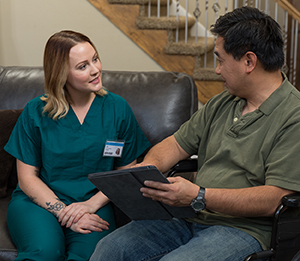What Is Hospice?
Hospice provides comfort and support to people nearing the end of life. This helps them and their family let go with dignity. Hospice focuses on quality of life. And it helps someone live their last days or months with a sense of control. Hospice programs support both the person and their family. They include physical, emotional, and spiritual services. This sheet tells you more about hospice. It may help you decide if this care is right for you or your loved one.

The goals of hospice
Hospice is a special type of care for people who are ill and are expected to have 6 months or less to live. Its goal is not to shorten life. Instead, the goal is to give comfort and support to a dying person and their loved ones. Hospice care helps to ease disease symptoms such as pain, upset stomach (nausea), and breathing problems. But treatments to cure a person's illness are stopped. Hospice also helps to meet the emotional and spiritual needs of a dying person and their family and friends.
Qualifying for hospice
A person with a life-limiting illness can go into hospice when a healthcare provider believes they have about 6 months or less to live. Hospice care can be used by people in the end stages of cancer, severe lung disease, heart failure, and other diseases. Hospice continues as long as it's needed. If a person’s health gets better, they can end the hospice care and start it again later. A person also has the right to leave hospice care at any time for any reason.
The services of hospice
Hospice is most often provided in the home. It can also be offered in a nursing home, assisted living facility, or hospital. This depends on the person's care needs. Hospice care is provided by a healthcare team that includes doctors, nurses, and other healthcare providers. A registered nurse case manager (RN case manager) coordinates care given by the hospice team. The team includes the hospice doctor and the person's personal doctor. They also provide skilled nursing care as needed. The RN case manager makes visits no less than every 14 days and more often as needed to meet the needs of the client and their family. Hospice also offers access to other providers. These include:
If hospice is done at home, family members give day-to-day care. Hospice support is given to the person and their family in many ways. This may include:
-
Making sure medicines are given for the person's comfort
-
Providing ongoing evaluations and care adjustments based on the person's comfort needs
-
Helping the family set up the home
-
Teaching the family about their loved one's medicines, how to give those medicines, and how to provide physical care
-
Supplying medical equipment as needed
-
Helping the family arrange 24-hour care
-
Helping the person and family find emotional, spiritual, and financial resources
-
Managing contact between the person, family, and healthcare providers
Help for loved ones in mourning (bereavement care) must be available for a year after the person’s death.
Common questions about hospice
Here are answers to some common questions about hospice care:
-
Where is hospice provided? Hospice is a method of care. It's not a physical location. It may be offered in the person’s home, a nursing home, a hospital, a designated hospice building, or in another facility.
-
Does hospice only offer 1 type of treatment? People in hospice care receive treatments and interventions to give them the most comfort and quality of life. In some cases, they may have the same treatments they received before hospice. This can include palliative chemotherapy, radiation, and heart failure treatments. People can also come and go from hospice at any time. Once a person leaves hospice, they may come back to the program at any time if they qualify. For instance, if their healthcare provider finds that they only have 6 months or less to live.
-
Can anyone who is ill receive hospice care? A person must have about 6 months or less to live to receive hospice.
-
Do people need a "Do not resuscitate" (DNR) order to receive hospice? In the U.S., people are not legally required to have made DNR arrangements to have hospice care. People must be informed that taking part in hospice is a choice to accept that death is coming. Aggressive life-sustaining treatments aren't part of hospice. These treatments include ventilator therapy, intensive care, and vasopressors.
-
What happens if the person lives longer than 6 months? About 1 in 10 people in hospice care live beyond the 6-month limit. When this happens, the hospice staff may discharge the person. If the healthcare provider continues to certify that the person is still close to dying, Medicare can continue to pay for hospice services.
-
Does hospice care shorten a person's life or bring about death? No. In fact, people in hospice care have been shown to live longer than people with similar illnesses who don't use hospice.
-
Can someone in hospice still keep their primary healthcare provider? Yes. The primary provider still plays an important role in the person's care.
Who pays for hospice?
Medicare and Medicaid cover hospice care for people age 65 or older. Most health insurance companies also cover hospice care. Hospice may be available at no extra charge as a free benefit. Talk with your healthcare provider to learn more about hospice services in your area.